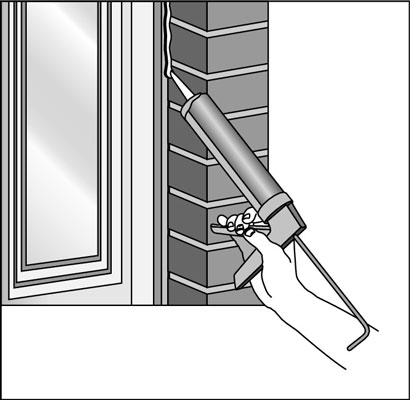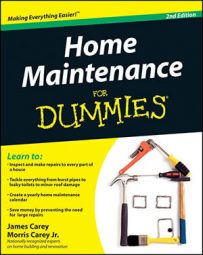You seal air leaks and water leaks around your windows in the same way — by caulking and replacing weatherstripping. You can also inject foam sealant between the frame of the window and the frame of the house.
A window that leaks air can also mean excessive energy loss and cost. Summer or winter, you don’t want your house to leak air, especially if you spend your hard-earned dollars warming or cooling it. Test a window for leaks by burning an incense stick near all its joints and connections. If the smoke flickers, you have an air leak. Check:
Where one section of the window meets another
Where the windows meet the frame
Where the frame meets the wall
Often, water leaks at a window result from a breakdown in the connection between the window frame and the wall. To prevent leaks, caulk the window where it meets the exterior siding. If the window is surrounded by wood trim, use a high-grade polyurethane caulk to seal all gaps between the trim and the siding (and the trim and the window).

Take special care to seal the top side of the top piece of trim. Puddling water at this location causes many window leaks.
If you’re willing to remove either your exterior or interior window trim, you can do a much better job of sealing window and door leaks — permanently! — than you can with just caulk. Using expanding foam not only prevents air infiltration, but it also makes the treated area watertight.
Here’s how to do it:
Use a pry bar and a hammer to remove the window trim (either inside or outside — not both).
Fill the void with expanding spray foam in a can.
Don’t worry about overfilling. Let it bulge out of the wall. What you don’t want to do is touch the foam while it’s wet; you’ll make a huge, hard-to-clean-up mess.
After the foam dries (it’ll take several hours), use a knife to cut off the excess.
Replace the trim in the reverse order in which you removed it and touch up paint as necessary.
Leaks also occur when weatherstripping wears out. You may have to remove the operable portion of the window to find the weatherstripping:
For sliding windows, open them halfway and lift the window out of the bottom track. Then pull the window out of the opening bottom first.
For single-hung windows, usually you just release a lever on the side track(s) of the window frame. Contact the manufacturer for specific instructions.
After you remove the operable portion of the window, it becomes pretty obvious where the weatherstripping is and how it has to be replaced. Most home centers offer replacement weatherstripping in peel-and-stick rolls. If you aren’t sure about what to do, take the section that you removed to the store with you or photograph the area that needs attention.
You may need an adhesive solvent to unstick old weatherstripping. Adhesive solvent is available in spray cans for easy application.
If you have metal or vinyl frame windows, check the drain holes at the outside edge of the bottom portion of the window frame. During rains, water can fill the bottom track, leak to the inside of the home, and flood the area surrounding the window. Drain or weep holes allow water to escape from the frame, preventing flooding. Use a piece of wire or a small screwdriver to ensure that the holes are clear.

